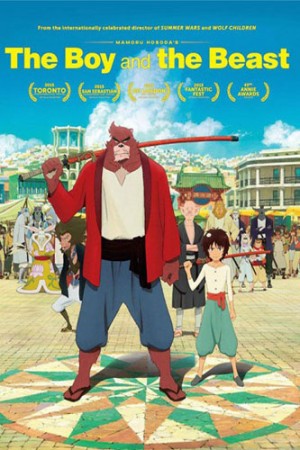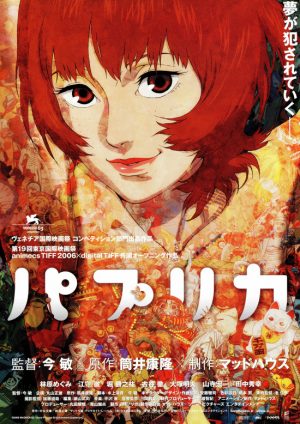
- Episodes : 1 (feature film)
- Genre : Coming of age, Action, Adventure, Supernatural
- Airing Date : July 2015
- Producers : Japan TV, Toho, Kadokawa Shoten, Studio Chizu
Bakemono no Ko Preview / Plot (No Spoilers)
After the sudden loss of his mother due to an accident, Ren wants to be with his father. But because of the court orders, he can't be with his father as a condition of his parents’ divorce prior to the movie. He refuses to be adopted and chooses to live homeless on the streets of the trendy Shibuya district in Tokyo. One day, he encounters two mysterious cloaked beasts and decides to follow them to an alternate dimension known as Shibutengai, in which its architecture takes influence from feudal Japan. As opposed to humans, beasts highly trained in the martial arts reside there. Ren then becomes a disciple of Kumatetsu, the beast who led him into Shibutengai, and lives the rest of his childhood there.
Who does Bakemono no Ko cater to?
Directed by Hosoda Mamoru, the director of The Girl Who Leapt Through Time, Summer Wars, and Wolf Children, anybody familiar with his previous works will naturally be attracted to this movie. If any of you readers enjoyed the newer Karate Kid movie, this feels a lot like it but with a much better soundtrack.
What's so appealing about this piece of work.
It has action, adventure, a bit of romance, and an excellently balanced mix of comedy and drama. For martial arts enthusiasts, this is also appealing since it does take a very realistic approach with some of the training sequences and that the lower body is a very important in generating the power and implementing the techniques. It is very cultural in its environment and people who have first hand experience living or traveling in Japan will instantly connect to it. For those that have never been to Japan, this could be educational.
Bakemono no Ko Trailer
Bakemono no Ko Main Characters List
Ren/Kyuuta
Voice Actor :Miyazaki Aoi (9-year-old); Sometani Shouta (17-year-old)
Ren starts out as a 9-year-old orphan who chooses to live homeless on the streets of Shibuya. Due to the loss of his mother and being unable to live with his father, he has a severe case of abandonment issues. He follows Kumatetsu, a bear who is also a martial arts master, into his world and has a very complicated but yet close relationship with him throughout the movie. After seeing that nobody would cheer for him in a street fight, Ren starts to see a lot of himself in Kumatetsu and decides to be his disciple. Since Ren does not tell Kumatetsu his real name and only his age, Kumatetsu renames him Kyuuta (kyuu 九meaning 9 and the kanji character for ta 太 is commonly used in boys’ names).
Kumatetsu
Voice Actor :Yakusho Kouji
As the kuma in his name indicates, the co-lead of this movie is a bear and a martial arts master who wants to be the next grand master. As a condition for candidacy, he is required to have a disciple. Because he couldn't get a disciple in Shibutengai since no one takes him seriously due to his reckless and immature nature, he takes Ren, a human boy as his disciple despite the potential consequences it could have on both of their worlds.
Kaede
Voice Actor :Hirose Suzu
After Ren’s return to the human world at the age of 17, the first person he befriends is Kaede, an over achieving high school girl. She is a top student due to the pressure of her parents to do well in school and go on to an elite university. She uses her acquired knowledge to help Ren re-integrate into the human world and instantly indicates an attraction to him.
Contains Spoilers
Bakemono no Ko Review
The first half of the story is focused on establishing Ren and Kumatetsu’s relationship and Ren’s training. This part of the story moves at a very fast pace and the audience has an opportunity to see the characters and their relationships evolve. The supporting cast members such as Tatara and Hyakushuubou are excellent foils to Ren and Kumatetsu’s hostilities towards each other, and they do a great job of helping the main duo bond and understand one another.
The movie also shows how Ren fits in Shibutengai first being ostracized for being a human, to eventually earning the respect the of the beasts with his black belt abilities, and establishing Kumatetsu’s reputation as a legitimate martial arts master. The second half then slows down and focuses on Ren finding his way back home to Tokyo after eight years and trying to catch up with what he missed out on.
The core characters are very relatable and their development really does capture you. Granted some of the themes of hard work and love conquering all have been done before but with the approach this story takes, it does feel fresh and makes you wonder where they can take it. My only issue with the movie is its villain, Ichirouhiko. I feel aspects of his presence are rushed and forced just for the sake of giving Ren a villain he could fight to show the results of his physical training and emotional growth.
The animation and character design are spectacular and nothing is exaggerated with the hair, eyes or clothing in a generic and trendy definition. I like how the animation is able to allow Kumatetsu to express all the emotions he has throughout the movie. He has a rough exterior and yet insecure, and I think the movie does a great job of conveying his feelings.
The fight scenes for the most part, even with the beasts, are taken with a much more realistic and technical approach. Even though the beasts do “power ups,” strategy, brains, and heart are a big part of what makes the fights exciting. I feel that some of the techniques used in this movie pay tribute to the long running boxing series, Hajime no Ippo. In one fight, a jolt counter is used, and Ren’s foundational training in just mimicking Kumatetsu’s movements also reminds me of how Miyata (a character from Hajime no Ippo who uses the jolt) learned boxing as well.
The most attractive quality of the art and animation is how it 100% accurately captures Shibuya, specifically the section outside the Hachikou exit of the station. The way the series portrays the Times Square of Tokyo, it’s as if you were there. Anybody who has been to Shibuya and watches this movie can probably say to themselves or with their friends that they have been to the Starbucks across the street of the station (where millions of people cross everyday), the burger king, the lotteria, the family mart, the Hokkaido ramen shop, the 109 shopping mall, the sbarro’s pizza (which is actually now closed), the HMV music store, the gusto restaurant, and so on (unfortunately, I couldn’t find the Taco Bell that just opened there).
Every location that is portrayed in the movie is real! The Shibuya library is realistically portrayed, too. So if anybody wants an anime where the audience can get a feel of the real Japan, this is the closest you can get. With Shibutengai, it reminds me of the ancient Kyoto that was portrayed in the hit SEGA game, Ryu Ga Gotoku Kenzan (known as Yakuza in the west). There are many open market stands, the houses all have their own mini farms and are much tinier than Japanese modern homes (which are small to begin with), and everything about it is more traditional which perfectly contrasts with the neon bright light district of Shibuya. The beasts wear traditional clothing such as kimonos or haoris, and actively engage in street fights where people take bets. The main voice cast contains a list of actors who have appeared in hit J-Dramas and movies. One big name actor in this movie is Yakusho Kouji, who plays Kumatetsu. If you are familiar with Japanese cinema, he played Sugiyama, the main character from the legendary hit, Shall We Dance (which was later adapted for American audiences starring Richard Gere and Jennifer Lopez), a must see for those interested in Japanese entertainment beyond anime.
He has this rough voice that appropriately fits the character both as a bear and with his rough edges, but yet has this soft spot for Ren. His voice reminds me of Koyama Rikiya’s portrayal of Takamura from Hajime no Ippo. Another big name to the cast is Aoi Miyazaki as the young Ren. She was the co-lead in the first live action Nana as Komatsu Nana, and also played Hana in Wolf Children, Hosoda’s previous film. Her performance is perfect at convincing audiences of Ren’s initial insecurities and his developed determination in becoming a good disciple for Kumatetsu.
Playing the 17-year-old Ren is Sometani Shouta, who you may know as Izumi Shinichi in the live action Parasyte (or Kiseiju for purists) movies. He does a great job of showing his maturity and how it contrasts with Kumatetsu’s irresponsible personality, and at the same time, exhibits his childlike curiosities of the changes around him when he returns to Tokyo.
The ending theme, Starting Over by Mr. Children, probably one of the best Japanese bands of all time, is a very touching way of closing the movie. It really fits the mood and excellently summarizes the story and where it goes once it ends without providing a sequel. The rest of the soundtrack is very serene, has this appropriate cultural feel in context to the rest of the film, and there is nothing more that can be said other than its perfect.
1. Ren and Kumatetsu
The relationship between Ren and Kumatetsu is the heart of this movie. Even though the antagonistic relationship between the immature father/master and the more serious son/disciple has been done many times before like in Ranma 1/2 and Garo, this brings a new twist to it since the audience is being treated to it from the very beginning while those relationships were on-going prior to the beginning of those two series.
At first, Ren wants nothing to do with Kumatetsu but sees they share very similar qualities when he sees him not being taken seriously by the citizens of Shibutengai. Kumatetsu on the other hand was never properly trained in the martial arts despite the townsfolk acknowledging him as one, but he shows an understanding of techniques.
As opposed to being trained by direct instruction, Ren initially just copies Kumatetsu’s footwork and lower body movement until it comes naturally to him and from there, then properly learns the other basics such as punching and using a sword. Even though their bickering continues throughout the movie, they always show that they got each other’s backs when it counts most.
2. Ren and Kaede
Through Kaede, the movie provides a very realistic portrayal of the consequences of Ren’s inability to go to school during his absence from his world. The first place he visits upon his return is the library, and is unable to read a significant number of kanji that a person his age should be able to read (one kanji is kujira 鯨 meaning whale).
He openly admits to Kaede that he has been unable to attend school and does not know anything. Though others would probably ridicule him for his illiteracy, Kaede takes the effort in tutoring Ren on what he missed out between forth and twelfth grade. In addition to teaching him kanji, she helps him in science, math, social studies and English. She goes as far as encouraging him to get a Japanese equivalent to a GED and go on to college.
Through Ren, her character develops in being more true to herself as individual as opposed to just being a mommy or daddy’s girl due to his more free spirited and self-driven nature.
3. Ren and his father
After years away from home and being away from his father, Ren manages to find him and catch up a bit. The father also reveals he never gave up looking for Ren after his mother died and always went to the police for updates. Even though their reunion is bittersweet, Ren’s upbringing in Shibutengai brings its set of complications as he tries to patch things up with his father.
As for why Ren couldn't live with his father after his mother died, the court ordered that they couldn't see each other again (at least until he's 18). This is also a very unfortunate reality in Japan’s super (and very painstaking) bureaucratic system that when couples divorce, the mother gets sole custody of the child, and the child doesn't see the father again until they are adults, or probably never again.
Concepts such as holiday visits or joint custody do not even exist in Japan. Even with the unfortunate passing of his mother, the court order still standing that Ren can’t be with his father is a further perfect extension of Japan’s bureaucracy and many foreigners who reside in Japan can relate to how it is very mendou kusai, or a pain in the neck.
After three great original hits, this is another achievement for Hosoda’s career as a director. He takes a lot of clichés and archetypes that have already been done before in the genre but makes them as good as new. It is also great to hear a voice cast that is not commonly used in the anime medium and further showcase their talents beyond live action.
And speaking of talent, other songs by Mr. Children are a must for people who want to get into Japanese music, and they are very rarely featured in anime compared to other famous Japanese artists such as L’arc~en~ciel. Last, if anyone wants to go to Shibuya in the future, this anime is a very excellent foundation to study from (unfortunately, the Hachikou statue is not at all featured, or the new Taco Bell that opened up back in May).
So when this is released in your respective country, please see it. If you are already in Japan, check it out while its still in theatres!
Recommended Post
Top 10 Anime Movies [Updated Best Recommendations]
Recommended Post



